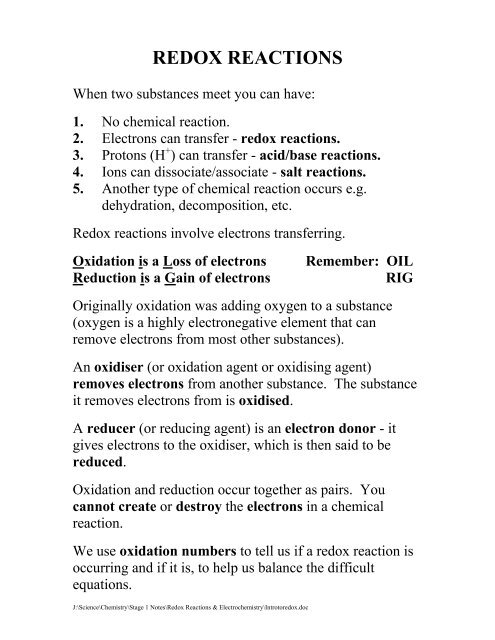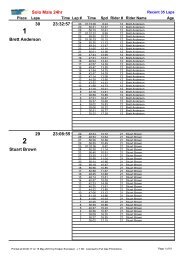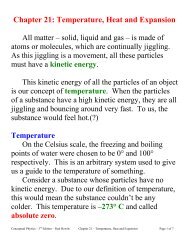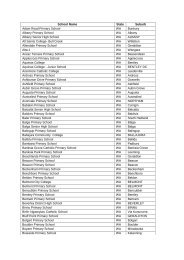stage 1 chemistry - redox reactions
stage 1 chemistry - redox reactions
stage 1 chemistry - redox reactions
You also want an ePaper? Increase the reach of your titles
YUMPU automatically turns print PDFs into web optimized ePapers that Google loves.
REDOX REACTIONSWhen two substances meet you can have:1. No chemical reaction.2. Electrons can transfer - <strong>redox</strong> <strong>reactions</strong>.3. Protons (H + ) can transfer - acid/base <strong>reactions</strong>.4. Ions can dissociate/associate - salt <strong>reactions</strong>.5. Another type of chemical reaction occurs e.g.dehydration, decomposition, etc.Redox <strong>reactions</strong> involve electrons transferring.Oxidation is a Loss of electronsReduction is a Gain of electronsRemember: OILRIGOriginally oxidation was adding oxygen to a substance(oxygen is a highly electronegative element that canremove electrons from most other substances).An oxidiser (or oxidation agent or oxidising agent)removes electrons from another substance. The substanceit removes electrons from is oxidised.A reducer (or reducing agent) is an electron donor - itgives electrons to the oxidiser, which is then said to bereduced.Oxidation and reduction occur together as pairs. Youcannot create or destroy the electrons in a chemicalreaction.We use oxidation numbers to tell us if a <strong>redox</strong> reaction isoccurring and if it is, to help us balance the difficultequations.J:\Science\Chemistry\Stage 1 Notes\Redox Reactions & Electro<strong>chemistry</strong>\Introto<strong>redox</strong>.doc
Rules for Assigning Oxidation Numbers1. The oxidation number of an element is zero.We put the oxidation number above the elements’symbol.0 0 0 0 0Na Cl 2 S 8 Fe H 2It can be a metal, non-metal, molecule, etc.2. The oxidation number of a monatomic ion is the sameas the charge on the ion. Oxidation numbers have asign. + and - signs must be shown.+1 -1 +3 +2 -2 -3Na + Cl - Fe 3+ Mg 2+ O 2- N 3-They range from -3 to +4.3. Bonded hydrogen is +1 (except in metal hydrideswhere it = -1 e.g. NaH where Na = +1 and H = -1).Bonded Oxygen is -2 (except in peroxides where it= -1 e.g. H 2 O 2 where H = +1 and O = -1).4. The oxidation numbers of a molecule must add toequal zero.+2 +4 -2CaCO 3 (+2) + (+4) + (-2 × 3) = 0+4 -2CO 2 (+4) + (-2 × 2) = 0+1 +6 -2H 2 SO 4 (+1 × 2) + (+6) + (-2 × 4) = 0Oxidation numbers indicate the charge on the atoms ifthey existed as ions.J:\Science\Chemistry\Stage 1 Notes\Redox Reactions & Electro<strong>chemistry</strong>\Introto<strong>redox</strong>.doc
5. The oxidation numbers of a polyatomic ion must addto equal the charge on that ion.+6 -2CrO 42-+4 -2CO 32-+7 -2MnO 4-(+6) + (-2 × 4) = -2(+4) + (-2 × 3) = -2(+7) + (-2 × 4) = -16. If hydrogen or oxygen is not present, we assign thenegative oxidation number to the mostelectronegative element.+4 -1CCl 4 (+4) + (-1 × 4) = 0If the oxidation number of any species changes, a <strong>redox</strong>reaction has occurred.In order to have a balanced <strong>redox</strong> reaction there must be aspecies that is oxidised another that is reduced.Oxidation - oxidation number increases.Reduction - oxidation number decreases.When wine goes‘off’ and turns tovinegar, and aniron nail rusts,oxidation hasoccurred in bothcases.J:\Science\Chemistry\Stage 1 Notes\Redox Reactions & Electro<strong>chemistry</strong>\Introto<strong>redox</strong>.doc

















